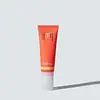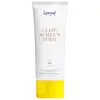What's inside
What's inside
 Key Ingredients
Key Ingredients

 Benefits
Benefits

 Concerns
Concerns

 Ingredients Side-by-side
Ingredients Side-by-side

Water
Skin ConditioningOctocrylene
UV AbsorberHomosalate
Skin ConditioningEthylhexyl Salicylate
UV AbsorberPhenylbenzimidazole Sulfonic Acid
UV AbsorberButyl Methoxydibenzoylmethane
UV AbsorberDiisopropyl Adipate
EmollientArginine
MaskingGlyceryl Oleate Citrate
EmulsifyingHydroxypropyl Starch Phosphate
Cetyl Alcohol
EmollientPhenyl Trimethicone
Skin ConditioningSilica
AbrasiveCarnosine
Skin ConditioningTetraselmis Suecica Extract
Skin ConditioningAloe Barbadensis Leaf Extract
EmollientBioflavonoids
Skin ConditioningBrassica Oleracea Italica Extract
AstringentTocopherol
AntioxidantPropanediol
SolventGlyceryl Stearate
EmollientPEG-100 Stearate
Glycerin
HumectantHydroxyacetophenone
AntioxidantCaprylic/Capric Triglyceride
MaskingPotassium Sorbate
PreservativeSodium Benzoate
Masking1,2-Hexanediol
Skin ConditioningCaprylyl Glycol
EmollientLactic Acid
BufferingWater, Octocrylene, Homosalate, Ethylhexyl Salicylate, Phenylbenzimidazole Sulfonic Acid, Butyl Methoxydibenzoylmethane, Diisopropyl Adipate, Arginine, Glyceryl Oleate Citrate, Hydroxypropyl Starch Phosphate, Cetyl Alcohol, Phenyl Trimethicone, Silica, Carnosine, Tetraselmis Suecica Extract, Aloe Barbadensis Leaf Extract, Bioflavonoids, Brassica Oleracea Italica Extract, Tocopherol, Propanediol, Glyceryl Stearate, PEG-100 Stearate, Glycerin, Hydroxyacetophenone, Caprylic/Capric Triglyceride, Potassium Sorbate, Sodium Benzoate, 1,2-Hexanediol, Caprylyl Glycol, Lactic Acid
Butyl Methoxydibenzoylmethane 3%
UV AbsorberHomosalate 7%
Skin ConditioningEthylhexyl Salicylate 5%
UV AbsorberOctocrylene 10%
UV AbsorberAletris Farinosa Root Extract
AntioxidantBisabolol
MaskingButyloctyl Salicylate
Skin ConditioningCalcium Sodium Borosilicate
Caprylhydroxamic Acid
Caprylic/Capric Triglyceride
MaskingCaprylyl Glycol
EmollientCetearyl Alcohol
EmollientCoco-Caprylate/Caprate
EmollientCoco-Glucoside
CleansingCoconut Alkanes
EmollientErythritol
HumectantEthyl Ferulate
AntioxidantEthylhexyl Methoxycrylene
Skin ConditioningGlycerin
HumectantGlyceryl Stearate
EmollientHydrogenated Polycyclopentadiene
Methyl Dihydroabietate
Mica
Cosmetic ColorantPolyester-8
Skin ConditioningPropanediol
SolventSodium Gluconate
Skin ConditioningSodium Polyacrylate Starch
AbsorbentSodium Stearoyl Glutamate
CleansingTitanium Dioxide
Cosmetic ColorantTocopherol
AntioxidantWater
Skin ConditioningXanthan Gum
EmulsifyingButyl Methoxydibenzoylmethane 3%, Homosalate 7%, Ethylhexyl Salicylate 5%, Octocrylene 10%, Aletris Farinosa Root Extract, Bisabolol, Butyloctyl Salicylate, Calcium Sodium Borosilicate, Caprylhydroxamic Acid, Caprylic/Capric Triglyceride, Caprylyl Glycol, Cetearyl Alcohol, Coco-Caprylate/Caprate, Coco-Glucoside, Coconut Alkanes, Erythritol, Ethyl Ferulate, Ethylhexyl Methoxycrylene, Glycerin, Glyceryl Stearate, Hydrogenated Polycyclopentadiene, Methyl Dihydroabietate, Mica, Polyester-8, Propanediol, Sodium Gluconate, Sodium Polyacrylate Starch, Sodium Stearoyl Glutamate, Titanium Dioxide, Tocopherol, Water, Xanthan Gum
Ingredients Explained
These ingredients are found in both products.
Ingredients higher up in an ingredient list are typically present in a larger amount.
Also known as Avobenzone, this ingredient is a chemical sunscreen filter that provides protection in the UV-A range.
Avobenzone is globally approved and is the most commonly used UV-A filter in the world.
Studies have found that avobenzone becomes ineffective when exposed to UV light (it is not photostable; meaning that it breaks down in sunlight). Because of this, formulations that include avobenzone will usually contain stabilizers such as octocrylene.
However, some modern formulations (looking at you, EU!) are able to stabilize avobenzone by coating the molecules.
Avobenzone does not protect against the UV-B range, so it's important to check that the sunscreen you're using contains other UV filters that do!
The highest concentration of avobenzone permitted is 3% in the US, and 5% in the EU.
Learn more about Butyl MethoxydibenzoylmethaneThis ingredient is an emollient, solvent, and texture enhancer. It is considered a skin-softener by helping the skin prevent moisture loss.
It helps thicken a product's formula and makes it easier to spread by dissolving clumping compounds.
Caprylic Triglyceride is made by combining glycerin with coconut oil, forming a clear liquid.
While there is an assumption Caprylic Triglyceride can clog pores due to it being derived from coconut oil, there is no research supporting this.
Learn more about Caprylic/Capric TriglycerideCaprylyl Glycol is a humectant and emollient, meaning it attracts and preserves moisture.
It is a common ingredient in many products, especially those designed to hydrate skin. The primary benefits are retaining moisture, skin softening, and promoting a healthy skin barrier.
Though Caprylyl Glycol is an alcohol derived from fatty acids, it is not the kind that can dry out skin.
This ingredient is also used as a preservative to extend the life of products. It has slight antimicrobial properties.
Learn more about Caprylyl GlycolEthylhexyl Salicylate is an organic compound used to block UV rays. It primarily absorbs UVB rays but offers a small amount of UVA protection as well.
Commonly found in sunscreens, Ethylhexyl Salicylate is created from salicylic acid and 2-ethylhexanol. You might know salicylic acid as the effective acne fighter ingredient and BHA.
The ethylhexanol in this ingredient is a fatty alcohol and helps hydrate your skin, similar to oils. It is an emollient, which means it traps moisture into the skin.
According to manufacturers, Ethylhexyl Salicylate absorbs UV wavelength of 295-315 nm, with a peak absorption at 307-310 nm. UVA rays are linked to long term skin damage, such as hyperpigmentation. UVB rays emit more energy and are capable of damaging our DNA. UVB rays cause sunburn.
Learn more about Ethylhexyl SalicylateGlycerin is already naturally found in your skin. It helps moisturize and protect your skin.
A study from 2016 found glycerin to be more effective as a humectant than AHAs and hyaluronic acid.
As a humectant, it helps the skin stay hydrated by pulling moisture to your skin. The low molecular weight of glycerin allows it to pull moisture into the deeper layers of your skin.
Hydrated skin improves your skin barrier; Your skin barrier helps protect against irritants and bacteria.
Glycerin has also been found to have antimicrobial and antiviral properties. Due to these properties, glycerin is often used in wound and burn treatments.
In cosmetics, glycerin is usually derived from plants such as soybean or palm. However, it can also be sourced from animals, such as tallow or animal fat.
This ingredient is organic, colorless, odorless, and non-toxic.
Glycerin is the name for this ingredient in American English. British English uses Glycerol/Glycerine.
Learn more about GlycerinGlyceryl Stearate is a mix of glycerin and stearic acid.
It is used to stabilize the mixing of water and oil ingredients. By preventing these ingredients from separating, it can help elongate shelf life. It can also help thicken the product's texture.
As an emollient, it helps soften skin and supports barrier-replenishing ingredients.
In cosmetics, Glyceryl Stearate is often made from vegetable oils or synthetically produced.
This ingredient may not be fungal-acne safe
Fun fact: The human body also creates Glyceryl Stearate naturally.
Learn more about Glyceryl StearateHomosalate is a chemical sunscreen filter that provides protection in the UV-B range (280nm - 320 nm), with a peak protection at 306 nm. It is internationally approved for use in sunscreens.
Homosalate is not photo-stable, meaning it's strength as a UV filter degrades over time with exposure to the sun. Because of this, it's often used in combination with other chemical sunscreen filters as avobenzone (which protects from the UV-A range). Homosalate also helps act as a solvent for harder-to-dissolve UV filters.
(Part of the reason that sunscreens need to be frequently re-applied is due to the photo instability of many chemical sunscreen filters)
Currently, homosalate is approved in concentrations up to 10% in the EU and 15% in the US. The FDA is currently doing further research on the effects of homosalate, and it is possible that these approved concentrations will change in the future.
Learn more about HomosalateOctocrylene protects skin from sun damage. It absorbs UV-B with peak absorption of 304 nm. It is a common sunscreen ingredient and often paired with avobenzone, a UVA filter. This is because octocrylene stabilizes other sunscreen ingredients by protecting them from degradation when exposed to sunlight. Octocrylene is a photostable ingredient and loses about 10% of SPF in 95 minutes.
Octocrylene also acts as an emollient, meaning it helps skin retain moisture and softens skin. It is oil-soluble and hydrophobic, enhancing water-resistant properties in a product.
Those who are using ketoprofen, a topical anti-inflammatory drug, may experience an allergic reaction when using octocrylene. It is best to speak with a healthcare professional about using sunscreens with octocrylene.
The EU allows a maximum of these concentrations:
Learn more about OctocrylenePropanediol is an all-star ingredient. It softens, hydrates, and smooths the skin.
It’s often used to:
Propanediol is not likely to cause sensitivity and considered safe to use. It is derived from corn or petroleum with a clear color and no scent.
Learn more about PropanediolTocopherol (also known as Vitamin E) is a common antioxidant used to help protect the skin from free-radicals and strengthen the skin barrier. It's also fat soluble - this means our skin is great at absorbing it.
Vitamin E also helps keep your natural skin lipids healthy. Your lipid skin barrier naturally consists of lipids, ceramides, and fatty acids. Vitamin E offers extra protection for your skin’s lipid barrier, keeping your skin healthy and nourished.
Another benefit is a bit of UV protection. Vitamin E helps reduce the damage caused by UVB rays. (It should not replace your sunscreen). Combining it with Vitamin C can decrease sunburned cells and hyperpigmentation after UV exposure.
You might have noticed Vitamin E + C often paired together. This is because it is great at stabilizing Vitamin C. Using the two together helps increase the effectiveness of both ingredients.
There are often claims that Vitamin E can reduce/prevent scarring, but these claims haven't been confirmed by scientific research.
Learn more about TocopherolWater. It's the most common cosmetic ingredient of all. You'll usually see it at the top of ingredient lists, meaning that it makes up the largest part of the product.
So why is it so popular? Water most often acts as a solvent - this means that it helps dissolve other ingredients into the formulation.
You'll also recognize water as that liquid we all need to stay alive. If you see this, drink a glass of water. Stay hydrated!
Learn more about Water